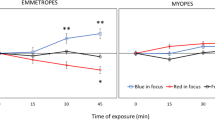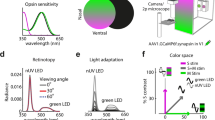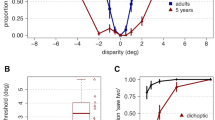Abstract
During development and aging and in amblyopia, visual acuity is far below the limitations set by the retina. Expression of brain-derived neurotrophic factor (BDNF) in the visual cortex is reduced in these situations. We asked whether neurotrophic tyrosine kinase receptor, type 2 (TrkB) regulates cortical visual acuity in adult mice. We found that genetically interfering with TrkB/BDNF signaling in pyramidal cells in the mature visual cortex reduced synaptic strength and resulted in a loss of neural responses to high spatial-frequency stimuli. Responses to low spatial-frequency stimuli were unaffected. This selective loss was not accompanied by a change in receptive field sizes or plasticity, but apparent contrast was reduced. Our results indicate that a dependence on spatial frequency in the Heeger normalization model explains this selective effect of contrast reduction on high-resolution vision and suggest that it involves contrast gain control operating in the visual cortex.
This is a preview of subscription content, access via your institution
Access options
Subscribe to this journal
Receive 12 print issues and online access
$209.00 per year
only $17.42 per issue
Buy this article
- Purchase on Springer Link
- Instant access to full article PDF
Prices may be subject to local taxes which are calculated during checkout







Similar content being viewed by others
References
Ress, D. & Heeger, D.J. Neuronal correlates of perception in early visual cortex. Nat. Neurosci. 6, 414–420 (2003).
Gianfranceschi, L., Fiorentini, A. & Maffei, L. Behavioural visual acuity of wild-type and bcl2 transgenic mouse. Vision Res. 39, 569–574 (1999).
Spekreijse, H. Comparison of acuity tests and pattern evoked potential criteria: two mechanisms underly acuity maturation in man. Behav. Brain Res. 10, 107–117 (1983).
Spear, P.D. Neural bases of visual deficits during aging. Vision Res. 33, 2589–2609 (1993).
Barrett, B.T., Bradley, A. & McGraw, P.V. Understanding the neural basis of ambylopia. Neuroscientist 10, 106–117 (2004).
Huang, Z.J. et al. BDNF regulates the maturation of inhibition and the critical period of plasticity in mouse visual cortex. Cell 98, 739–755 (1999).
Katoh-Semba, R., Semba, R., Takeuchi, I.K. & Kato, K. Age-related changes in levels of brain-derived neurotrophic factor in selected brain regions of rats, normal mice and senescence-accelerated mice: a comparison to those of nerve growth factor and neurotrophin-3. Neurosci. Res. 31, 227–234 (1998).
Bozzi, Y. et al. Monocular deprivation decreases the expression of messenger RNA for brain-derived neurotrophic factor in the rat visual cortex. Neuroscience 69, 1133–1144 (1995).
Rossi, F.M., Bozzi, Y., Pizzorusso, T. & Maffei, L. Monocular deprivation decreases brain-derived neurotrophic factor immunoreactivity in the rat visual cortex. Neuroscience 90, 363–368 (1999).
Heimel, J.A., Hartman, R.J., Hermans, J.M. & Levelt, C.N. Screening mouse vision with intrinsic signal optical imaging. Eur. J. Neurosci. 25, 795–804 (2007).
Sale, A. et al. Environmental enrichment in adulthood promotes amblyopia recovery through a reduction of intracortical inhibition. Nat. Neurosci. 10, 679–681 (2007).
Maya Vetencourt, J.F. et al. The antidepressant fluoxetine restores plasticity in the adult visual cortex. Science 320, 385–388 (2008).
Gianfranceschi, L. et al. Visual cortex is rescued from the effects of dark rearing by overexpression of BDNF. Proc. Natl. Acad. Sci. USA 100, 12486–12491 (2003).
Huang, E.J. & Reichardt, L.F. Neurotrophins: roles in neuronal development and function. Annu. Rev. Neurosci. 24, 677–736 (2001).
Lu, B. Acute and long-term synaptic modulation by neurotrophins. Prog. Brain Res. 146, 137–150 (2004).
Chakravarthy, S. et al. Postsynaptic TrkB signaling has distinct roles in spine maintenance in adult visual cortex and hippocampus. Proc. Natl. Acad. Sci. USA 103, 1071–1076 (2006).
McAllister, A.K., Katz, L.C. & Lo, D.C. Neurotrophins and synaptic plasticity. Annu. Rev. Neurosci. 22, 295–318 (1999).
Poo, M.M. Neurotrophins as synaptic modulators. Nat. Rev. Neurosci. 2, 24–32 (2001).
Eide, F.F. et al. Naturally occurring truncated trkB receptors have dominant inhibitory effects on brain-derived neurotrophic factor signaling. J. Neurosci. 16, 3123–3129 (1996).
Sawtell, N.B. et al. NMDA receptor-dependent ocular dominance plasticity in adult visual cortex. Neuron 38, 977–985 (2003).
Dahlhaus, M. et al. Notch1 signaling in pyramidal neurons regulates synaptic connectivity and experience-dependent modifications of acuity in the visual cortex. J. Neurosci. 28, 10794–10802 (2008).
Gordon, J.A. & Stryker, M.P. Experience-dependent plasticity of binocular responses in the primary visual cortex of the mouse. J. Neurosci. 16, 3274–3286 (1996).
Li, Y.X. et al. Expression of a dominant-negative TrkB receptor, T1, reveals a requirement for presynaptic signaling in BDNF-induced synaptic potentiation in cultured hippocampal neurons. Proc. Natl. Acad. Sci. USA 95, 10884–10889 (1998).
Binzegger, T., Douglas, R.J. & Martin, K.A. A quantitative map of the circuit of cat primary visual cortex. J. Neurosci. 24, 8441–8453 (2004).
Kohara, K. et al. A local reduction in cortical GABAergic synapses after a loss of endogenous brain-derived neurotrophic factor, as revealed by single-cell gene knock-out method. J. Neurosci. 27, 7234–7244 (2007).
Bradley, A., Skottun, B.C., Ohzawa, I., Sclar, G. & Freeman, R.D. Visual orientation and spatial frequency discrimination: a comparison of single neurons and behavior. J. Neurophysiol. 57, 755–772 (1987).
Albrecht, D.G., Geisler, W.S., Frazor, R.A. & Crane, A.M. Visual cortex neurons of monkeys and cats: temporal dynamics of the contrast response function. J. Neurophysiol. 88, 888–913 (2002).
Heeger, D.J. Normalization of cell responses in cat striate cortex. Vis. Neurosci. 9, 181–197 (1992).
Albrecht, D.G. & Hamilton, D.B. Striate cortex of monkey and cat: contrast response function. J. Neurophysiol. 48, 217–237 (1982).
Bartoletti, A. et al. Heterozygous knock-out mice for brain-derived neurotrophic factor show a pathway-specific impairment of long-term potentiation but normal critical period for monocular deprivation. J. Neurosci. 22, 10072–10077 (2002).
Kaneko, M., Hanover, J.L., England, P.M. & Stryker, M.P. TrkB kinase is required for recovery, but not loss, of cortical responses following monocular deprivation. Nat. Neurosci. 11, 497–504 (2008).
Carmignoto, G., Pizzorusso, T., Tia, S. & Vicini, S. Brain-derived neurotrophic factor and nerve growth factor potentiate excitatory synaptic transmission in the rat visual cortex. J. Physiol. (Lond.) 498, 153–164 (1997).
Heimel, J.A., Van Hooser, S.D. & Nelson, S.B. Laminar organization of response properties in primary visual cortex of the gray squirrel (Sciurus carolinensis). J. Neurophysiol. 94, 3538–3554 (2005).
Issa, N.P., Trepel, C. & Stryker, M.P. Spatial frequency maps in cat visual cortex. J. Neurosci. 20, 8504–8514 (2000).
Skottun, B.C., Bradley, A. & Ramoa, A.S. Effect of contrast on spatial frequency tuning of neurones in area 17 of cat's visual cortex. Exp. Brain Res. 63, 431–435 (1986).
Sceniak, M.P., Hawken, M.J. & Shapley, R. Contrast-dependent changes in spatial frequency tuning of macaque V1 neurons: effects of a changing receptive field size. J. Neurophysiol. 88, 1363–1373 (2002).
Morrone, M.C., Burr, D.C. & Speed, H.D. Cross-orientation inhibition in cat is GABA mediated. Exp. Brain Res. 67, 635–644 (1987).
Carandini, M. & Heeger, D.J. Summation and division by neurons in primate visual cortex. Science 264, 1333–1336 (1994).
Carandini, M., Heeger, D.J. & Movshon, J.A. Linearity and normalization in simple cells of the macaque primary visual cortex. J. Neurosci. 17, 8621–8644 (1997).
Sengpiel, F. & Vorobyov, V. Intracortical origins of interocular suppression in the visual cortex. J. Neurosci. 25, 6394–6400 (2005).
Kayser, A., Priebe, N.J. & Miller, K.D. Contrast-dependent nonlinearities arise locally in a model of contrast-invariant orientation tuning. J. Neurophysiol. 85, 2130–2149 (2001).
Carandini, M., Heeger, D.J. & Senn, W. A synaptic explanation of suppression in visual cortex. J. Neurosci. 22, 10053–10065 (2002).
Chance, F.S., Nelson, S.B. & Abbott, L.F. Synaptic depression and the temporal response characteristics of V1 cells. J. Neurosci. 18, 4785–4799 (1998).
van Rossum, M.C., van der Meer, M.A., Xiao, D. & Oram, M.W. Adaptive integration in the visual cortex by depressing recurrent cortical circuits. Neural Comput. 20, 1847–1872 (2008).
Priebe, N.J. & Ferster, D. Mechanisms underlying cross-orientation suppression in cat visual cortex. Nat. Neurosci. 9, 552–561 (2006).
Li, B., Thompson, J.K., Duong, T., Peterson, M.R. & Freeman, R.D. Origins of cross-orientation suppression in the visual cortex. J. Neurophysiol. 96, 1755–1764 (2006).
Bradley, A. & Freeman, R.D. Contrast sensitivity in anisometropic amblyopia. Invest. Ophthalmol. Vis. Sci. 21, 467–476 (1981).
Heynen, A.J. et al. Molecular mechanism for loss of visual cortical responsiveness following brief monocular deprivation. Nat. Neurosci. 6, 854–862 (2003).
Bartoletti, A., Medini, P., Berardi, N. & Maffei, L. Environmental enrichment prevents effects of dark-rearing in the rat visual cortex. Nat. Neurosci. 7, 215–216 (2004).
Acknowledgements
We thank S. Nelson for reading the manuscript and, together with S. Van Hooser, for visual stimulation software, A. Maffei and C. de Zeeuw for discussions, R. Hartman for assistance with monocular deprivation, S. Škulj-Živkovic, S. Scheltinga and S. Riahi for genotyping and C. Pool and J. van Heerikhuize for puncta analysis macros. C.N.L., J.A.H. and J.M.H. were supported by SenterNovem BSIK grant 03053. S.C. was supported by Rotterdamse Vereniging Blindenbelangen, Algemeen Nederlandse Vereeniging ter Voorkoming van Blindheid and Stichting Blindenhulp. C.N.L. and M.H.S. were supported by a ZonMW Vidi grant.
Author information
Authors and Affiliations
Contributions
C.N.L. generated the TrkB.T1-EGFP mice. J.A.H. and C.N.L. devised the experiments and wrote the manuscript. J.A.H. performed the in vivo experiments and implemented the normalization model. M.H.S. carried out the slice experiments. S.C. analyzed parvalbumin puncta. J.M.H. assisted with imaging.
Corresponding author
Ethics declarations
Competing interests
The authors declare no competing financial interests.
Supplementary information
Supplementary Text and Figures
Supplementary Figures 1–9 and Supplementary Equations (PDF 4863 kb)
Rights and permissions
About this article
Cite this article
Heimel, J., Saiepour, M., Chakravarthy, S. et al. Contrast gain control and cortical TrkB signaling shape visual acuity. Nat Neurosci 13, 642–648 (2010). https://doi.org/10.1038/nn.2534
Received:
Accepted:
Published:
Issue Date:
DOI: https://doi.org/10.1038/nn.2534
This article is cited by
-
Chronic bisphenol A exposure triggers visual perception dysfunction through impoverished neuronal coding ability in the primary visual cortex
Archives of Toxicology (2022)
-
Reliable detection of low visual acuity in mice with pattern visually evoked potentials
Scientific Reports (2018)
-
Functional modulation of primary visual cortex by the superior colliculus in the mouse
Nature Communications (2018)
-
Visual Processing by Calretinin Expressing Inhibitory Neurons in Mouse Primary Visual Cortex
Scientific Reports (2018)
-
Mir-132/212 is required for maturation of binocular matching of orientation preference and depth perception
Nature Communications (2017)



